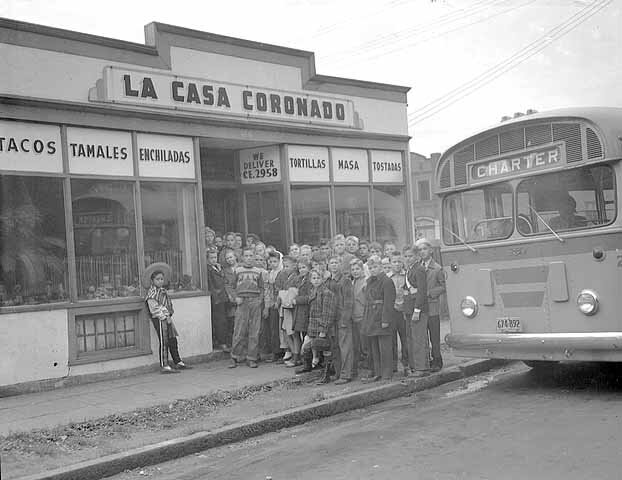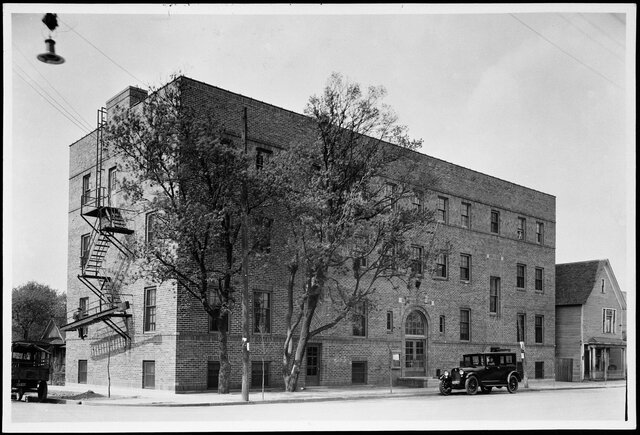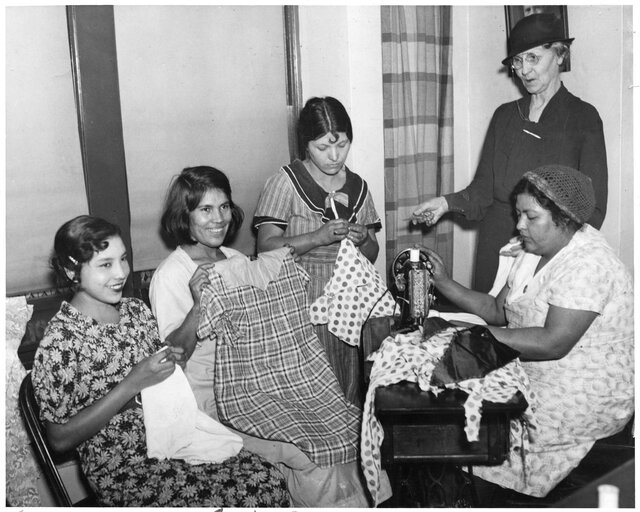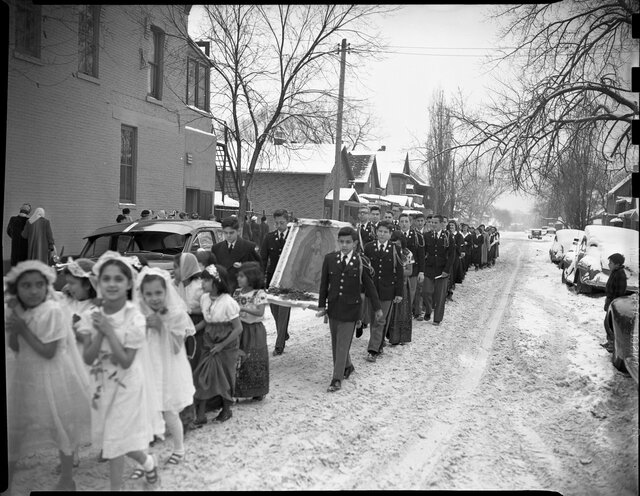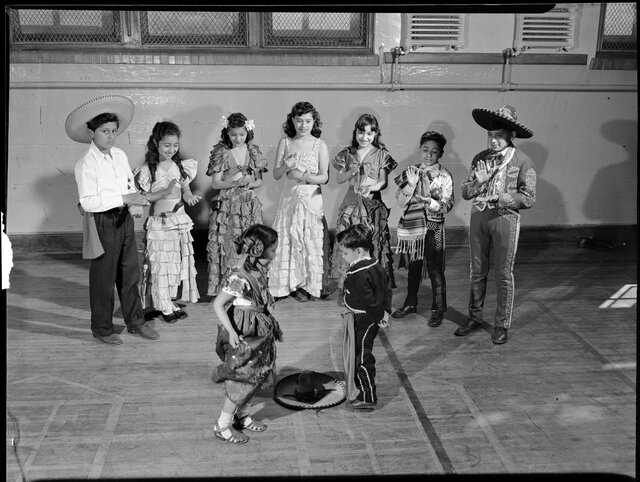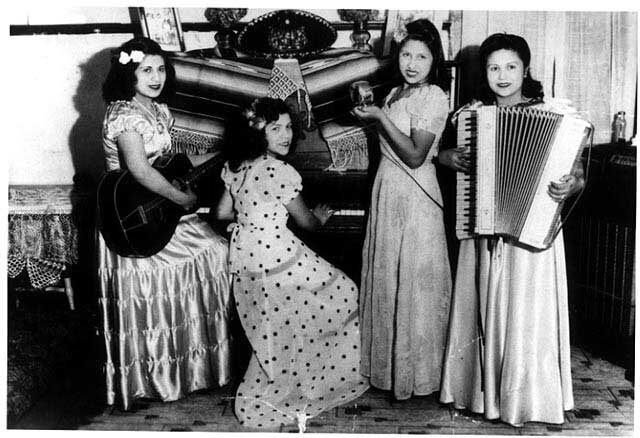Hispanic Heritage Month in Minnesota
Hispanic Heritage Month is a holiday to reflect on the contributions and culture of Hispanic and Latino/a people in the United States. Locally, the Latino/a community culturally and economically developed the West Side Flats neighborhood along the Mississippi River. Although residents and business owners were displaced when the city demolished the neighborhood and replaced it with an industrial park in 1964, the community continues to thrive today in the surrounding area centered on District del Sol in Saint Paul.
Paul Nelson writes in Saint Paul Historical, “People of Mexican origin or descent began to come to Saint Paul around the time of World War I. Oftentimes they were migrant agricultural workers who found year-round work in the railroads, local shops and factories, or the South Saint Paul stockyards. Most of them lived on the West Side Flats [along the Mississippi River], and some Saint Paul families with Spanish surnames have been here for nearly a century. For decades they made up an urban village; around 70 people in 1920, 630 by 1930, and up to 1,000—a quarter of the Flats’ population—by 1940.”
The West Side Flats was the largest and longest-inhabited river flat in the Twin Cities. The 400-acre section centered between the Wabasha Street Bridge and the Robert Street Bridge was prone to annual spring flooding. Housing was affordable attracting immigrants, migrants, and refugees, but plumbing and electricity were sparse. Still, the community developed its own businesses and notable institutions in the neighborhood, and some of them still exist today in new locations!
Luis Garzón’s grocery store - a central hub where people could meet, shop, and speak their own language. Luis is recognized as the first Latino to permanently make Minnesota his home in 1886.
La Casa Coronado - established in 1946; considered the only Mexican restaurant in the state at the time.
The Anáhuac Society - founded in 1922; provided resources and a safe place for immigrants to gather. (Anáhuac means “near the water” or “land on the edge of the water” in Nahuatl, the ancient Aztec language spoken in Tenochtitlan, Mexico.)
Neighborhood House - began as a settlement house to serve immigrants on St. Paul’s West Side and continues to be a thriving cultural hub where civic, recreational, and community events and activities engage the whole West Side neighborhood.
Our Lady of Guadalupe Church - the oldest established Catholic Hispanic church in the state.
Jackie Renzetti writes on The Current blog, “In the 1940s, Las Hermanas Rangel were a popular Mexican-American music group in Saint Paul’s West Side, known for their romantic ballads and fast-paced corridos. The sisters were darlings of the West Side, singing at community dances, restaurants, parties and church events. The trio, consisting of sisters Eugenia, Genevieve and Maria Rangel, often performed with different variations of their brothers’ bands. In their heyday, the siblings sang with their brother Francisco (“Kico”) in the Kico Rangel band, which played popular mambos and cha-chas. Their parents, Francisco and Crescencia Rangel, helped organize celebrations for traditional Mexican holidays and were known as West Side community leaders.”
Augie Garcia was another local music icon living on the West Side. His recording of “Hi Yo Silver” is thought to be the first rock and roll record ever made in the Twin Cities. In 1956, it was reported that he almost upstaged Elvis Presley as his opening act in the Saint Paul Auditorium. Elvis’s manager yanked Augie and his band off stage prematurely in fear that his high-energy act would steal the show.
In "Chicano Movement in Westside Saint Paul," Shirley Saldivar writes, “Much of the housing on the Lower West Side was eventually considered uninhabitable due to the area’s high risk of flooding. A flood in 1952 caused 2,641 residents to evacuate, and a second flood in 1957 emphasized a need for a long-term solution. The neighborhood had already become a target for urban renewal, and the Saint Paul Port Authority had announced in 1956 that the Riverview Industrial District project would demolish the community. Families were reluctant to leave their homes, stores, schools, and churches, even though they were promised jobs in Riverview. The city completed the project in 1964 at a cost of $9 million for the construction and $4 million for relocation costs, but the jobs didn’t come in the quantity promised.”
“The insult to injury was that after we moved, they built a floodwall to protect this area. That has never sat right with any of us that grew up down here,” Don Luna, a former resident of West Side Flats, said in a video interview. “Had you taken care of us, then maybe we could’ve done something with that housing and we could’ve kept our neighborhood. We lost a piece of our history and in many ways a piece of who we were. That piece is gone and we can’t get that back.”
For more information, check out "Absent Narratives: Saint Paul’s West Side," a series of short videos by Minnesota Humanities Center that explores the history and development of Saint Paul’s West Side into a thriving business center of Latina/o culture and commerce. The series includes videos on reconstruction of the neighborhood, music influences, and community cornerstones like Neighborhood House and Our Lady of Guadalupe Church.
“Usumacinta Meets the Mississippi”
A limestone sculpture that is meant to represent the ties between the waters of Mexico City and the waters of the Mississippi River stands tall at Indian Mounds Regional Park. The sculpture, Javier Del Cueto, is a well-known artist who teaches sculpture in Mexico City and has studied in Spain. The Usumacinta River is a river in southeastern Mexico and northwestern Guatemala.
“Javier became enamored by the Mississippi River and it became the inspiration for this work,” Steve Trimble writes in Saint Paul Historical. “Javier explained that, ‘Mexico is a country with a strong tradition in stone carving from Pre-Hispanic and Colonial times to the present.’ One of his goals is to carry on and add to the appreciation of this art form in his homeland.”
The sculpture’s limestone is sourced from the Vetter Quarry in Kasota, Minnesota. It is located near the intersection of Mounds Park Boulevard and McLean, overlooking the Mississippi River.
Outdoor Groups:
Outdoor Latino Minnesota (Facebook) / Outdoor Latino Minnesota (Instagram)
Outdoor Latino Minnesota hosts events within the Twin Cities metro area including Three Rivers Park District, Anoka County, Dakota County, and more.
Huellas Latinas MN (website) / Huellas Latinas MN (Facebook)
Birding, youth field trips, family walks, hiking club, outdoor challenges, and more for the Latino/a community in the Twin Cities metro area.
Yoga Para La Gente (Facebook)
Outdoor yoga classes taught in Spanish.
Outdoor Afro - Minnesota
Outdoor Afro is a community that reconnects Black people with natural spaces and one another through recreational activities such as camping, hiking, biking, birding, fishing, gardening, skiing, and more!
BIPOC Outdoors Twin Cities (Facebook group)
This group was created for Twin Cities residents who self-identify as Black, Indigenous and/or People of Color who also work and/or recreate in the outdoors. Join to learn about upcoming outdoor recreational and learning events for people of color, led by people of color.
Latino Senior Engagement pilot program (Three Rivers Park District)
This program seeks to engage Latino seniors with the objective of reducing social isolation and loneliness by providing a place to connect and find overall wellness through active experiences in the outdoors. If you know of Latino seniors who would like to be a part of this program in 2022, contact giannina.posner@threeriversparks.org or 763-694-2046.
Outdoor Employment Opportunities:
Latino Heritage Internship Program (National Park Service)
The Latino Heritage Internship Program (LHIP) is a partnership with the National Park Service and Environment for the Americas designed to provide internship opportunities for young adults, with an emphasis on Latinos, in a variety of career fields. The program helps raise awareness of public lands, including national parks, and engage the next generation of stewards. Learn more on the National Park Service website.
AmeriCorps: Community Volunteer Ambassador - June Cohort (National Park Service)
The Community Volunteer Ambassador (CVA) June cohort is designed to engage youth of color in the National Park Service. Members will be placed at NPS sites nationwide and will organize, lead, and participate in community and volunteer activities and events.
AmeriCorps (National Park Service / Mississippi Park Connection)
Mississippi River Fellowship (Mississippi Park Connection)
With the long-term goal of creating a park staff that is more representative of the communities it serves, this paid fellowship provides an opportunity for diverse and underrepresented young adults ages 18-25 to explore a career path in the environmental field. This 10-week fellowship explores the different branches of the National Park Service.
Outdoor Articles:
Five Latinas Championing Diversity In The Outdoors (Luz Collective)
Here are five inspiring Latina women diversifying the outdoors who are ready to be your guide down any trail.
Leading the Latino/a Community Outdoors (National Park Foundation)
Latino Outdoors is an organization that is working to create a national community of leaders in conservation and outdoor education for the next generation and beyond.
Friendship, health, community: Twin Cities Latino cyclists on a roll (Minnesota Public Radio)
Latino Social Biking is a Twin Cities group helping Latino people connect, get healthy and get past the isolation and sedentary influences of the pandemic.
Why Hispanic outdoor participation is on the rise (Appalachian Mountain Club)
Hispanics enjoy regular time outdoors at nearly twice the rate they did a decade ago—and population changes aren’t the only reason why.
Minnesota looks to address disparities in outdoor recreation (Minnesota Public Radio)
Host Angela Davis talked with two outdoor activists who started outdoor recreation groups about the work they are doing and how to make Minnesota’s outdoor spaces more inclusive.
A push to make Minnesota’s outdoors more inviting and inclusive (Sahan Journal)
People of color make up about 20 percent of Minnesota’s population, but only about 5 percent of state park visitors.
Understanding our Complicated Relationship with Hispanic Heritage Month
Amy Dominguez and Gabi Rivera of HECHO (Hispanics Enjoying Camping, Hiking, and the Outdoors) provide a great overview of certain terms (such as race vs ethnicity) and the etymology and geographical context of Hispanic vs Latino/Latinx.

